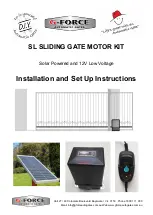
7
S A F E T Y I N S TA L L AT I O N I N F O R M AT I O N
Warning - To reduce the risk of SEVERE INJURY or DEATH from an incorrect installation:
1. Vehicular gate systems provide convenience and security. Gate systems are comprised of many component parts. The gate oper-
ator is only one component. Each gate system is specifically designed for an individual application.
2. Gate operating system designers, installers and users must take into account the possible hazards associated with each individual
component. Poorly designed, installed or maintained gate systems may be dangerous to users and bystanders. Gate installers
and designers should therefore take steps to reduce the publicʼs exposure to potential hazards.
3. A gate operator can generate a great deal of force during operation, installers must be mindful of this fact. Safety features must be
incorporated into every design. Specific safety features include:
• Gate Edges
• Guards for exposed rollers
• Photoelectric Sensors
• Vertical Posts
• Instructional and Precautionary Signage
4. A gate opener should only be installed where:
a. The operator is appropriate for the construction and the usage class of the gate.
b. All exposed pinch points are eliminated or guarded, and guarding is supplied for exposed rollers.
5. The operator is intended for installation only on vehicular gates only, pedestrians should be supplied with a seperate access
6. The gate must be installed in a location so that enough clearance is supplied between the gate and adjacent structures when
opening and closing to reduce the risk of entrapment. Swinging gates shall not open into public access areas.
7. The gate must be properly installed and work freely in both directions prior to the installation of the gate operator.
8. Controls must be far enough from the gate so that the user is prevented from coming in contact with the gate while operating the
controls.
9. Any warning signs must be clearly visible, on each side of the gate.
10. For a gate operator utilising a non-contact sensor:
a. Reference ownerʼs manual regarding placement of non-contact sensor for each type of application.
b. Care shall be exercised to reduce the risk of nuisance tripping, such as when a vehicle trips the sensor while the gate is still
moving.
c. One or more non-contact sensors shall be located where the risk of entrapment or obstruction exists, such as the perimeter
reachable by a moving gate or barrier.
11. For a gate operator utilizing a contact sensor such as an edge sensor:
a. A hard wired contact sensor shall be located and its wiring arranged so the communication between the sensor and the gate
operator is not subject to mechanical damage.
b. A wireless contact sensor such as the one that transmits radio frequency (RF) signals to the gate operator for entrapment pro-
tection functions shall be located where the transmission of the signals are not obstructed or impeded by building structures,
natural landscaping or similar obstruction. A wireless contact sensor shall function under the intended end-use conditions.
c. One or more contact sensors shall be located at the leading edge, trailing edge and post mounted both inside and outside of a
vehicular horizontal slide gate.
d. One or more contact sensors shall be located at the bottom edge of a vehicular vertical lift gate.
e. One or more contact sensors shall be located on the inside and outside leading edge of a swing gate. Additionally, if the bottom
edge of a swing gate is greater than 15cm (6”) above the ground at any point in its arc of travel, one or more contact sensors
shall be located on the bottom edge.
IMPORTANT SAFE OPERATING/MAINTENANCE
INSTRUCTIONS
To reduce the risk of SEVERE INJURY or DEATH:
1. READ AND FOLLOW ALL INSTRUCTIONS.
2. NEVER allow children to operate or play with gate
controls. Keep the remote control away from chil-
dren.
3. ALWAYS keep people and objects away from the
gate. NO ONE SHOULD CROSS THE PATH OF
THE MOVING GATE.
4. Test the gate operator monthly. The gate MUST re-
verse on contact with a rigid object or stop when an
object activates the non-contact sensors. After ad-
justing the force or the limit of travel, retest the gate
operator. Failure to adjust and retest the gate opera-
tor properly can increase the risk of INJURY or
DEATH.
5. Use the manual release ONLY when the gate is not
moving.
6. KEEP GATES PROPERLY MAINTAINED. Read the
ownerʼs manual. Have a qualified service person
make repairs to gate hardware.
7. The entrance is for vehicles ONLY. Pedestrians
MUST use separate entrance.
8. This appliance is not intended for use by persons
(including children) with reduced physical sensory or
mental capabilities, or lack of experience and
knowledge, unless they have been given supervision
or instruction concerning use of the appliance by a
person responsible for their safety.
Summary of Contents for MGA600
Page 15: ...14 Transformer...
Page 20: ...19...
Page 21: ...20 left right NOTES...
Page 22: ...21 TIMER TO CLOSE T b w r t p TTC OFF MAXIMUM time 180 seconds...
Page 23: ...22 C840...
Page 25: ...24 CAUTION 240 VAC Transformer...
Page 27: ...26...
Page 28: ...27...
Page 29: ...28...









































